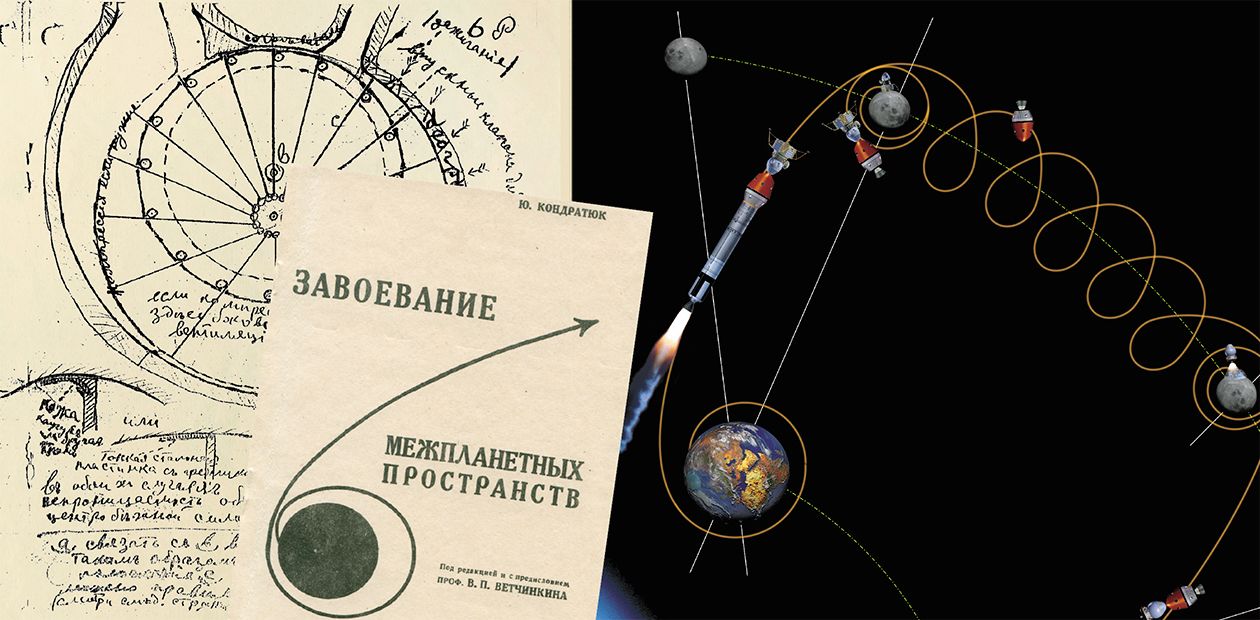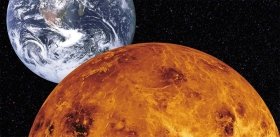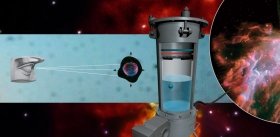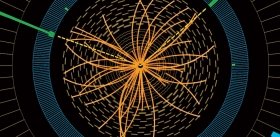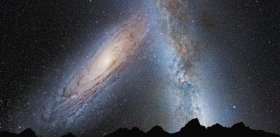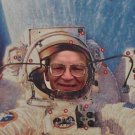"...How We Could All Cut Capers in the Universe!"
For ages man dreamt about going to the Moon, the largest object in the night sky. Science fiction writers wrote about it, philosophers speculated about it, scientists racked their brains over it being sure that the Earth is only a “children’s room” for the mankind. With the dawn of the space era this fanciful lunar dream turned into an immense engineering project. On July 21st, 1969 American astronaut Neil Armstrong stepped on the surface of the Moon. “That’s one small step for man, but a giant leap for mankind,” were his words that spread all over the world.
In 1997 the author of this article translated into English Yu.V. Kondratyuk’s book “The Conquest of Interplanetary Space”, published in 1929 and sent it to researcher John Houbolt, the author of the Apollo Moon project. In response, he received a detailed NASA report prepared in 1995 about the history of the lunar mission called Lunar-Orbit Rendezvous, or LOR, and J. Houbolt’s role in its realisation. On the cover J. Houbolt wrote: “It is of interest to see how much his ideas and my ideas were similar.”
Hence, according to his own acknowledgement, the scheme of the flight to the Moon the Americans implemented had been invented by the Russian engineer 50 years before the Apollo flight.
Is it possible that the Americans used Yu.V. Kondratyuk’s idea? This question was broadly discussed in the Russian media, while the trajectory of flight to the Moon began to be called “Kondratyuk’s loop.” This is what this article tells us about and also, it answers the question of who Yu.V. Kondratyuk was in reality
Both Cyrano de Bergerac in the Travel to the Moon and Jules Verne in the novel Around the Moon suggested using a rocket ship for man’s flight into space. With the dawn of the 20th century, scientific and engineering research of the idea of rocket flights began to be carried out in different countries of the world: Hermann Oberth in Germany, Robert Esnault-Pelterie in France, Robert H. Goddard in the USA and others. Without doubt, the priority in this field belongs to the Russian scientist Konstantin E. Tsiolkovsky, who published the article Exploration of the Universe with Reaction Machines in 1903. This work laid the foundation for the science of reaction propulsion. Even though it does not contain any information about the project that would have made it possible to reach the surface of the Moon and return to the Earth, it is important that orbital space stations are mentioned in this work.
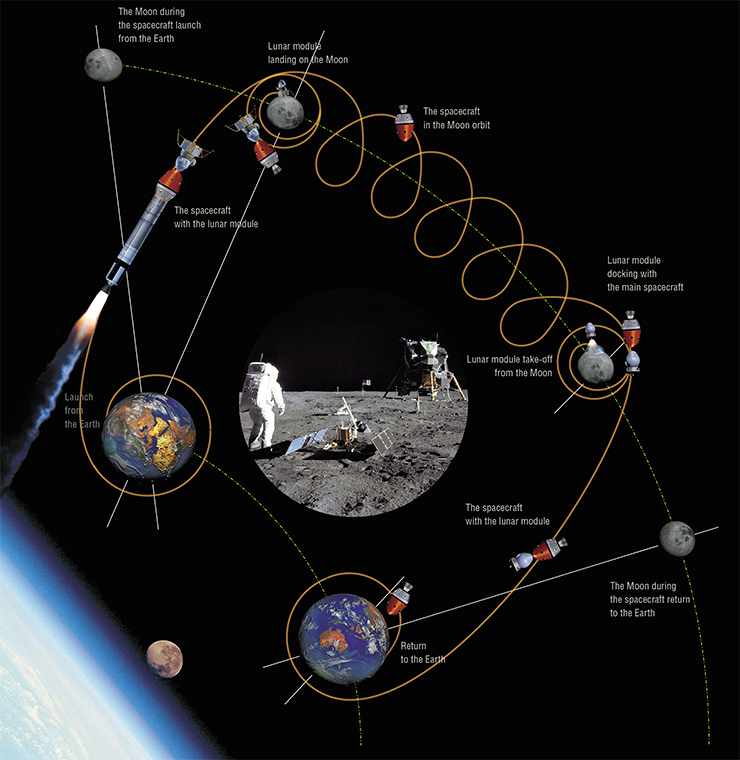
The idea of the “earth-orbit rendezvous” is very important for the development of the theory of aeronautics. Only in science fiction stories spacecrafts travel the depths of the universe without taking into consideration energy expenditure. In reality, the amount of fuel necessary to overcome the gravitation of the earth, enter the circumterrestrial orbit, slow down before landing on another planet, and then take off and bring the spacecraft to the Earth requires such initial rocket mass that makes the flight itself impossible. Thus, “earth-orbit rendezvous” is the necessary destination on the route of deep-space spacecrafts.
Earth-orbit rendezvous
The idea of using space stations for distant flights was first expressed in 1897 in the work of the German professor K. Lasswitz On Two Planets (for the development of the concept of “earth-orbit rendezvous” see Hacker, 1974). In 1924 the German researcher H. Oberth published a small book entitled Rocket into Interplanetary Space in which he proposed to build a station-satellite of the Earth with an observatory, solar battery and fuel supply necessary to make flights into deep space. In the end of the 1920s the Journal of the German Rocket Society published a series of articles on this topic.
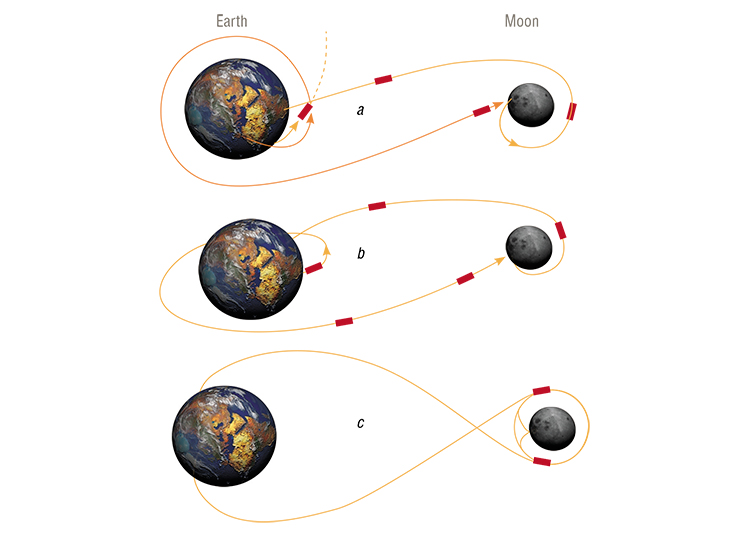
After the end of the Second World War profound work on developing its aerospace research was done by the British Interplanetary Society (BIS). In January 1949 the BIS journal published the article Orbital bases. Its author H. Ross suggests that not one but three rockets should be launched from the Earth followed by their earth orbital docking. Having finished refueling, one of them flies to the Moon and back. Such a scheme requires launching a rocket weighing 1326 tons only instead of one weighing 3460 tons necessary for a direct flight from the Earth to the Moon. After this scheme had been improved it was made public during the session of the International Aeronautics Congress which took place in London in 1951.
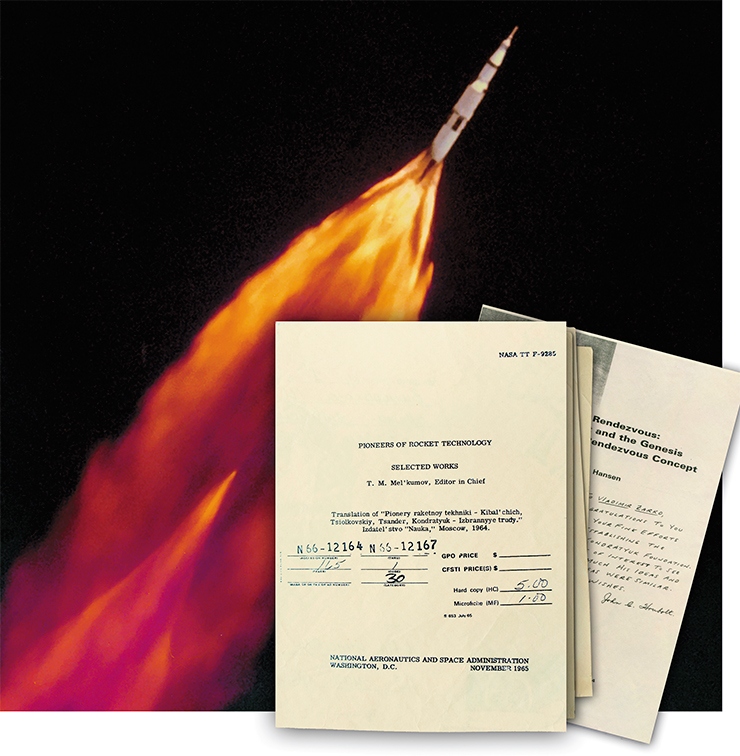
In the beginning of the 1960s, the USA proclaims the Program of manned flight to the Moon. When discussing the possible variants of the flight, National Aeronautics and Space Administration (NASA) considers the project of direct expedition to the Moon with the rocket weighing more than 5000 tons – and this is after the idea of “earth-orbit rendezvous” received international recognition! However, the majority of NASA rocket team together with its leader Dr. Wernher von Braun support the project with the tentative name EOR (earth orbit rendezvous), an “earth-orbit rendezvous.” According to this project, two rockets are launched into space: one of them with fuel and the other one with the spacecraft; after refueling in the Earth’s orbit the spacecraft with astronauts goes straight to the Moon.
He went through the same as I did!
An alternative variant of the earth-orbit rendezvous was suggested by the NASA engineer John Houbolt. He calculated that it would be more reasonable to send one powerful rocket to the Moon’s orbit with a detachable module, which can descend to the Moon’s surface and then return to the orbit and dock with the main spaceship. In the beginning Houbolt’s proposal seemed rather unusual, so that he had to demonstrate remarkable persistence defending his brainchild before the NASA administration. A similar idea was then proposed by other researchers as well, specifically the NASA employee V. Michael and Thomas Dolan from Vought Astronautics. In the end, Houbolt’s project was considered as the most meaningful from the technical point of view and perspective.
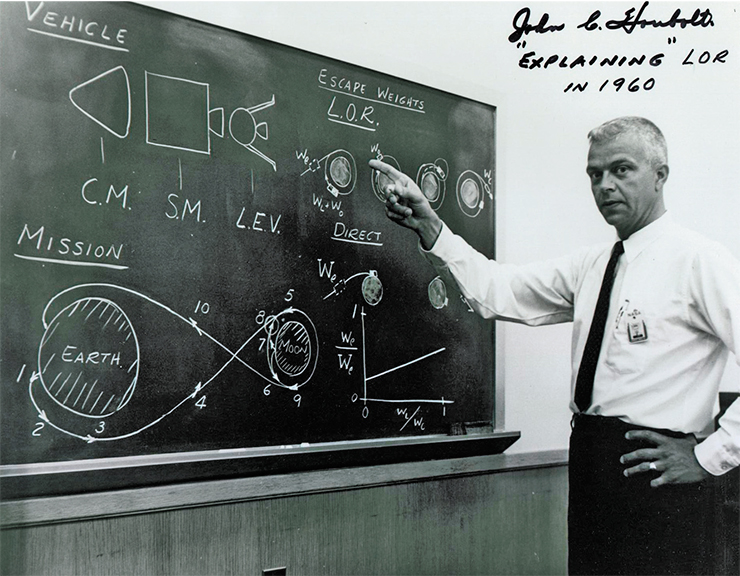
We can receive not only an opportunity to take off from the Earth and return but also move freely around the Solar system and even leave it altogether.
If it were possible to fly there with the help of cannon and return with the help of the atmosphere, having at hand on the rocket measurable quantity of active substance, we could all cut capers in the universe.”
Yu. V. Kondratyuk “To those who will read in order to build” (1918–1919)
“To prevent the module from swaying which could interfere with the observations made through a large astronomical instrument, the module’s mass should be divided into four parts placing it in the tetrahedron tops and connecting them with each other with the aluminium truss. If people are badly influenced by a long-term absence of apparent gravity, then … their living space can be arranged separately and joined to a counterbalance with a cable several dozen meters long; if this system is imparted rotation around a common center of gravity, then centripetal acceleration will appear which can be felt in the same way as the Earth’s gravity.”
Yu. V. Kondratyuk “The Conquest of Interplanetary Space,” 1929
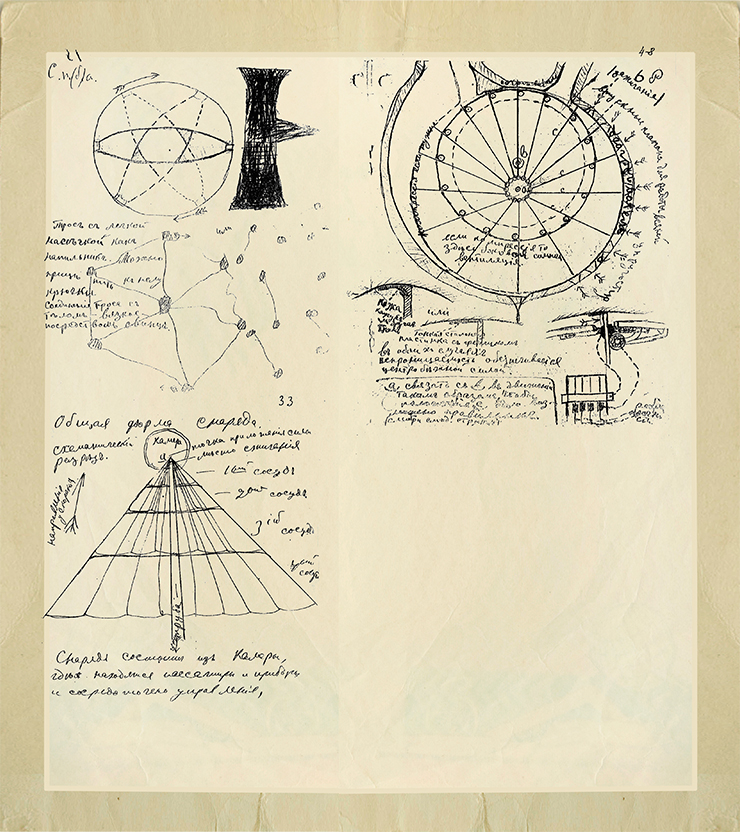
“The rocket consists of a chamber where the passengers and the equipment are located and from which the vessels containing active substance are controlled. It also contains the tubes where the combustion of the active substance as well as its expansion and that of its gases takes place… Several vessels different in size should be made. Each vessel should have two compartments, for liquid oxygen and hydrogen.”
Yu. V. Kondratyuk “To those who will read in order to build,” 1918–1919
“We can use sunlight on the rocket for the preliminary heating of oxygen and hydrogen before they are fed into the tube. It will allow us to achieve high launching velocity, higher recoil. To use solar light on the rocket it is necessary to have at hand mirrors of considerable size. These mirrors must be made of the thinnest plates of some metal which could reflect as large a percentage of solar light as possible.
We shall make large size mirrors in great number, send them to the orbit and bring to such a condition that they will become the earth’s satellites. Then they should be positioned on the orbit and joined into larger ones still by common frames. After that we will start controlling them. If the number of mirrors goes into dozens, then they can be used to illuminate the streets of the capital. But if a large amount of money is attracted to the project, if many mirrors are produced and placed around the earth so that they will be exposed to the solar light, then part of the earth’s surface can be warmed up by them; the tundra and taiga can be made fertile. Maybe, using large amounts of heat and energy produced by them it would be possible to make some other planet suitable for human habitation, remove harmful substances from it, supply the necessary ones and warm it up.
Altogether with the help of large amounts of energy it is possible to make the most incredible ideas come true.”
Yu. V. Kondratyuk “The Conquest of Interplanetary Space,” 1929
![A page from Kondratyuk’s manuscript To those who will read in order to build where the process of receiving oxygen-hydrogen fuel for the rocket using solar energy is described. “Besides the usual methods, we can use the heat received from the sun to decompose water as follows: water goes through a tube, the heated object, and decomposes from high temperature. Then the mixture is fed into a double-wall tube (the inner one being porous), where hydrogen partially separates from oxygen due to diffusion. Thus what is received in the tube is: Tube a: water and oxygen. Tube b: water and hydrogen. Then all three of them are sent with the back current past the water fed into the heater to transfer the heat preserved after decomposition to it, while (non-diffused) water is fed into the heater too. Oxyhydrogen or oxygen and hydrogen separately can be fed [into the combustion engine].” The Archive of the Vavilov Institute of History of Natural Sciences and Technology RAS A page from Kondratyuk’s manuscript To those who will read in order to build where the process of receiving oxygen-hydrogen fuel for the rocket using solar energy is described. “Besides the usual methods, we can use the heat received from the sun to decompose water as follows: water goes through a tube, the heated object, and decomposes from high temperature. Then the mixture is fed into a double-wall tube (the inner one being porous), where hydrogen partially separates from oxygen due to diffusion. Thus what is received in the tube is: Tube a: water and oxygen. Tube b: water and hydrogen. Then all three of them are sent with the back current past the water fed into the heater to transfer the heat preserved after decomposition to it, while (non-diffused) water is fed into the heater too. Oxyhydrogen or oxygen and hydrogen separately can be fed [into the combustion engine].” The Archive of the Vavilov Institute of History of Natural Sciences and Technology RAS](/files/medialibrary/7f6/7f6725ea1385480343b8b612bc864941.jpg)
“Why has the problem of interstellar communication not been resolved in practice so far? It is not that immense as regards the necessary technical resources but at the same time is of immeasurably great importance. Posing this question, it can be concluded that the reason for it is a lack of audacity and initiative on the one hand, and a lack of understanding of this task’s practical importance, on the other. If the goal of this task were expressed in dollars and were not infested with the idea of its own extraordinary nature, the Americans would probably gain excess to it and would not be at the stage of preliminary experiments similarly to the Germans, which went in the wrong direction as far as it is possible to judge from our newspaper resources.
In 1921 I found quite an unexpected solution to the problem of establishing a constant communication channel between the Earth and interplanetary spaces for the purposes of which it is necessary to use a rocket only once. In 1926 I came up with a similar solution to the problem of reaching the initial speed of 1500-2000 m/sec the rocket needs to develop without using a vehicle and at the same time without using an enormous gun-tunnel, superpowerful engines or even some gigantic constructions. These chapters were not included in the present book because they are too similar in content for them to be published without knowing in advance who and how is going to use these data.”
Yu. V. Kondratyuk “The Conquest of Interplanetary Space,“ 1929
One of the March issues of Life magazine (1969) published an article telling the difficult story of the project Apollo. Houbolt’s words were used in the headline of the article: “If there is any idea we must push, it’s this one.” It was published on the occasion of Apollo-9 trial flight. According to the words of the article’s author David Sheridan while observing its launch Houbolt remembered about the Russian engineer “whose dreams were broken by the skepticism of the others.” As the journalist pointed out, “Quite recently Houbolt have read the work by Yuri Kondratyuk, the Russian self-taught mechanic. 50 years ago he calculated that LOR is the best way to land on the Moon. The Soviet government neglected it…” “Oh, God, he has gone through the same as I have!” exclaimed Houbolt. “Thinking about it I could not restrain my emotions when I was watching Apollo-9 take-off.”
Later these Houbolt ‘s words were interpreted wrongly. In many publications that appeared in the Russian media the article in Life was used as a proof that NASA had used the ideas of the Russian engineer. It is evident that such arguments are based on the absence of familiarity with the material. After all, according to the journalist, in the article Houbolt admits that he read Yu. Kondratyuk’s work but does not specify which one in particular and when; however, this information is easy to check.
Around the planet as a satellite
The only Kondratyuk’s publication during his life was The Conquest of Interplanetary Space published in 1929 in Novosibirsk. The author put forward many outstanding, often visionary ideas, but there is no mention of a scheme of flight to the other planets which could have become a prototype for the American LOR.
Kondratyuk discusses this question in a completely different work To Those Who Will Read in order to Build. This was the first work by Yuri Vasiliyevich written as early as 1916—1919, which existed as a handwritten copy. It was published in 1964, only when the Institute of Natural History and Technology (USSR Academy of Sciences) published the book Pioneers of Rocket Technology. Kibalchich, Tsiolkovsky, Tsandler, Kondratyuk. Selected works.
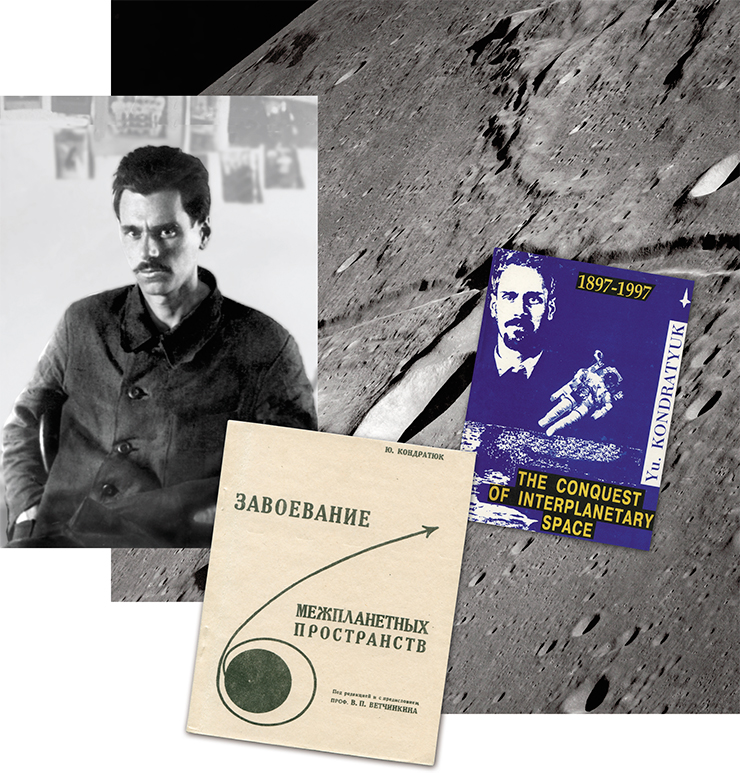
The next year Americans made a technical translation of this book. Probably this is the translation of Kondrayuk’s manuscript Sheridan refers to in his article. It means that Houbolt and other specialists from NASA only learned about Kondratyuk’s scheme in 1965.
It should be said that Kondratyuk himself did not consider his proposal as a final project. It was just an idea, one of those brilliant guesses of which his work is full. This is what he said: “It is obvious not to leave the whole rocket on the planet, but to launch it as a satellite (around the planet), and make a stop with the part of the rocket necessary for stopping on the planet and docking back with the vehicle.” It is evident that using a small part of the rocket for landing makes it possible to save fuel and thus diminish the initial rocket mass approximately to one-half, according to the later calculations. Thus, currently this scheme is the only possible solution.
This remarkable idea does credit to the Russian inventor, but it is wrong to say that the American scientists “borrowed” it. In the history of science there are numerous examples when the same ideas and technical solutions come to completely different people. It simply means that the time for them has come. By the 20th century, the mankind was on the verge of the cosmic era, and it is not important who was the first.
Being ahead of time
Unfortunately, Kondratyk’s idea about how to land on other planets was not the only one that was discovered anew in the works of the scientists whose research was made later. According to the words of Academician V. P. Glushko, one of the founders of the Russian rocketry, Yu. Kondratyuk’s works “are full of the most interesting ideas and suggestions which are used nowadays and will be used for a long time in the future.” He deserves a place among the first theoreticians of aeronautics, next to Tsiolkovsky.
Many of Yu. Kondratyuk’s suggestions have been used in the practice of space flights. He independently derived the main equation for rocket motion; proved that a rocket cannot leave the boundaries of the Earth’s gravity without dropping the fuel tanks; suggested a principle scheme and description of a four-stage rocket; suggested using the gravity of the celestial bodies when calculating spacecraft trajectory.
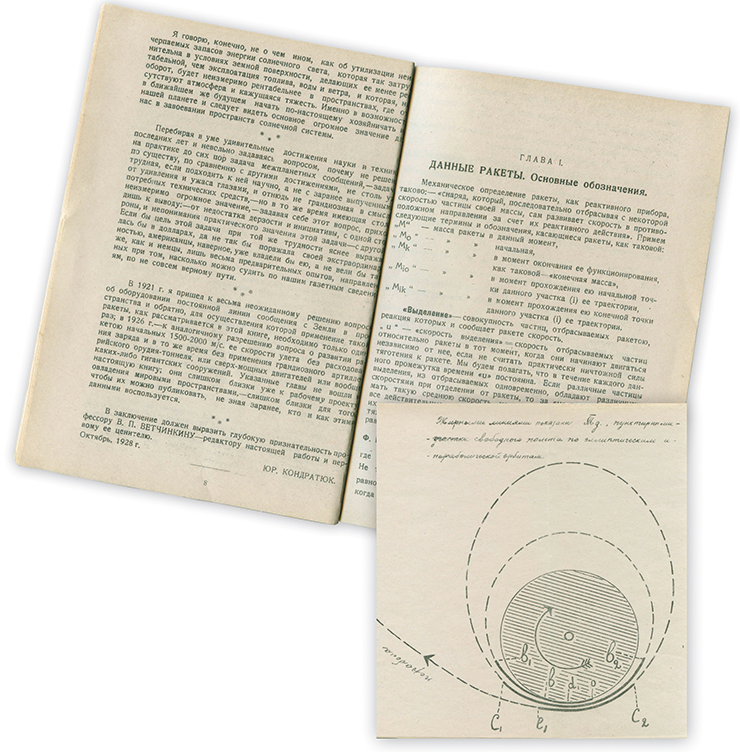
For future flights in the Solar system Kondratyuk suggested that a “transitional interplanetary base” should be created, including bases on the planets with a lower level of gravity than that of the Earth. This idea was first realised in the Soviet Union, and now it has found its realisation in the International Space Station. Probably over the next 20 years such station will appear on the Moon. At least, this is one of China’s ambitious plans.
To conquer the interplanetary space, Kondratyuk made up a “glider-like rocket” tightly coated “with some substance with a maximal fire resistance.” This is the technology used in modern rocket-gliders Shuttle and Buran. More than that, they also land according to the scheme once proposed by Kondratyuk: to lower the flight velocity, the spacecraft periodically enters the Earth’s atmosphere on the rebound.
For a walk in space Kondratyuk advised to leave the spacecraft through an airlock, in special spacesuits and with supply of air. He foresaw that during takeoff and landing “excessive acceleration can be harmful and even deadly for the pilot.” To prevent the “motion of blood mass,” Kondratyuk suggested “placing a naked body in a smooth but form-fitting suit.” At present during takeoff and landing spacemen use special chairs-cradles.
Kondratyuk also expressed many interesting ideas about the rocket propellant. For his four-stage rocket he suggested using oxygen-hydrogen propellant. This is the propellant which the most powerful rocket engines made in America and France use. To increase the efficiency of rocket propellant, the researcher suggested adding metal to it: either rocket parts molten in a special oven (furnace) or in a powder form. If the former seems to be impossible to realize at present, the latter has found broad use in the production of different types of fuel, including the rocket one.
Yuri Vasiliyevich paid great attention to the use of solar energy. In his opinion, with the help of mirrors-concentrates it is possible to satisfy spacecraft’s needs, while with the help of large mirrors located on artificial satellites it is possible to illuminate the planets, “to warm up tundra and taiga poles and make them fertile.” More than that, “using the enormous amount of heat and energy delivered to them it could be possible to adjust some other planet for eventual human habitation.”
A unique experiment conducted on February 4, 1993 on the Russian orbital complex Mir demonstrated that it is quite possible to do it. At the height of 400 km over the Earth’s surface, a mirror umbrella 20 m in diameter was erected, and splashes of sunlight several dozen meters in diameter danced through Lyon, Genève, Munich, Prague, Brest and Gomel.
In the nearest decades
This is a telling example. Even the most fantastic ideas with which Yu. Kondratyuk came up can find application if not today then in the future. It should be said that Yu. Kondratyuk is reasonably cautious in his predictions and recommendations. In the first foreword to The Conquest of Interplanetary Space he cautioned the readers that many formulae and “almost all numbers are given in a simplified form and are rounded, often rather roughly.” For a similar reason there are no constructive or working drawings in Kondratyuk’s work: general principles of constructions can be easily expressed verbally. Kondratyuk was aware that he did not have enough data to formulate engineering projects in their final versions; however, he found it possible to present the general directions of work.
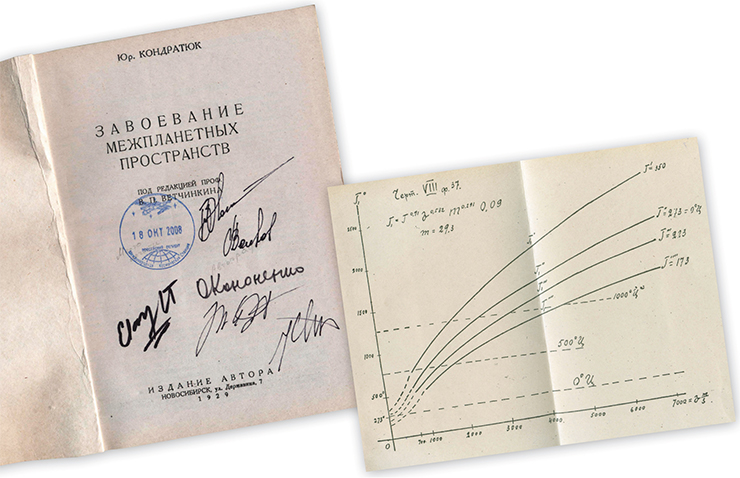
In the second foreword to The Conquest of Interplanetary Space Yuri Vasilievich enumerated the main perspectives in space exploration awaiting the mankind “in the nearest decade at most counting from the first flight from the Earth”:
“1) Without doubt, considerable enrichment of scientific knowledge reflected in corresponding technological changes.
2) Possible enrichment of the equipment with valuable substances which can be found on the other bodies in the Solar system and which are either absent or too rare on the Earth’s surface.
3) Other presents from the Solar system are possible, which we cannot foresee at present and which can be or can not be, such as, for example, the link with the probable organic world on Mars.
4) An opportunity to get hold of the resources with the help of which it will be possible to improve the living conditions on the Earth’s surface dramatically: to carry out its melioration on a vast scale by taking such measures as, for example, climate change on whole continents” (Kondratyuk, 1929).
Talking about “taking hold of the resources”, the author means not the fuel, water and wind but inexhaustible supply of solar energy, using which is “immeasurably more effective in spaces without the atmosphere and apparent gravity” than in conditions of the Earth’s surface.
“This is in the possibility to start using our planet’s resources more fully that we should see the great importance of managing different corners of the Solar system”, concludes the researcher.
It is amazing that the ideas formulated in the first half of the 20th century remain urgent until now. Tragic events of the past century reflected in the fate of Yu. Kondratyuk did not allow him to fully realize his unique talents of a researcher, inventor and pathfinder. But his ideas became the first step, having climbed which, the mankind was able to launch an artificial earth satellite, send man into space and step on the Moon’s surface. It is possible that in the future more than on one occasion there will be a chance to remember this remarkable scientist who was dreaming about the conquest of the interplanetary space among the ruins because “a flight on a rocket into the depths of the space is not something surprising or incredible.”
References
Kondratjuk Ju. V. Zavoevanie mezhplanetnyh prostranstv / Pod red. prof. V. P. Vetchinkina. Novosibirsk, 1929. 72 s.
Pionery raketnoj tehniki: Kibal’chich, Ciolkovskij, Cander, Kondratjuk: izbr. trudy / AN SSSR; In-t estestvoznanija i tehniki. M.: Nauka, 1964. 672 s.
Hacker Barton C. The Idea of Rendezvous: From Space Station to Orbital Operations in Space Travel Thought, 1895–1951 // Technology and Culture 15. July 1974. P. 373–388.
Sheridan, David. If there is any idea we must push, it’s this one // Life. 1969. V. 66. N 10. P. 20–24.


